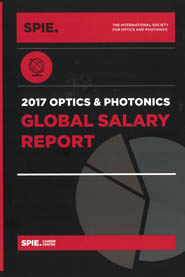New analysis topics added to annual industry survey by SPIE, the international society for optics and photonics
 |
BELLINGHAM, Washington, USA, and CARDIFF, UK — Differences of opinion still exist when it comes to fair pay and promotion, but job satisfaction remains high overall in optics and photonics fields, according to the recently published 2017 SPIE Optics and Photonics Global Salary Report. The report, the seventh compiled annually by SPIE, the international society for optics and photonics, and the largest such international study of the photonics industry, offers insights into additional new areas.
This year’s report presents in-depth, detailed information on salaries in individual countries by career stage, organization type, and job level. For example, median salaries by career stage are reported for the first time for Australia, Brazil, Canada, India, Mexico, the Netherlands, Switzerland, and Taiwan. Also new to the report is a breakdown by engineers or non-engineers and startup or non-startup companies.
Aerospace is still the highest-paid discipline with a median income of US$110,000, according to the report a position it has held throughout the survey’s history.
Women and men reported similar levels of job satisfaction in most categories: 96% enjoy their work, 95% find their work meaningful, and 93% feel that their work is respected by their peers.
Nearly equal percentages of women (82%) and men (83%) would recommend their job to a child or a friend.
The largest difference of opinion in the survey concerns employee views on fairness of pay and promotion. The report shows that 71% of women feel they are paid fairly, versus 79% of men. With few exceptions, the report shows, women still earn less than men overall. The largest wage differences between men and women are associated with North American and higher-income Asian countries, employment at not-for-profit organizations, and employment of 26-30 years.
“A solid grounding in optics and photonics has provided many of us opportunities to rewarding careers. This will continue to be the case in this century of the photon as the impact of our technologies on quality and quantity of life continues its inexorable progress,” said SPIE CEO Eugene Arthurs.
Opportunities will continue, but changes will as well, he noted.
“To maximize the rewards from intellectual stimulation that are so important to many of us, and to be well rewarded financially, we must be open to change, perhaps to the challenges and social disruption of migration. Human talent is globally dispersed, but the distribution of brains does not correlate with the geographic disparity in salaries,” Arthurs noted. He referenced a table showing pay by country, with median salaries ranging from US$117,000 in the United States to less than US$3,000 in Ukraine.
“As invention and entrepreneurship proliferate in our field, salary differentials may diminish, but in this regard as in much else, hope is not a strategy,” Arthurs said. “Learning from the success of Taiwan, Korea, and Singapore in investing in the complete innovation infrastructure from education to global product revenues is a better approach for countries without legacy technology-based economies. And unless the established leading economies pay attention to the investment in education and research, future versions of this salary survey will have ranking changes.”
North America and Oceania stand out as the regions with the highest salaries, with median earnings well above other areas. North American median incomes are 86% greater than higher-income Asian countries and more than double higher-income European countries.
Among other findings:
About SPIE
SPIE is the international society for optics and photonics, an educational not-for-profit organization founded in 1955 to advance light-based science, engineering, and technology. The Society serves nearly 264,000 constituents from approximately 166 countries, offering conferences and their published proceedings, continuing education, books, journals, and the SPIE Digital Library. In 2016, SPIE provided $4 million in support of education and outreach programs. www.spie.org
Contact:
Amy Nelson
Public Relations Manager
amy@spie.org
+1 360 685 5478
@SPIEtweets